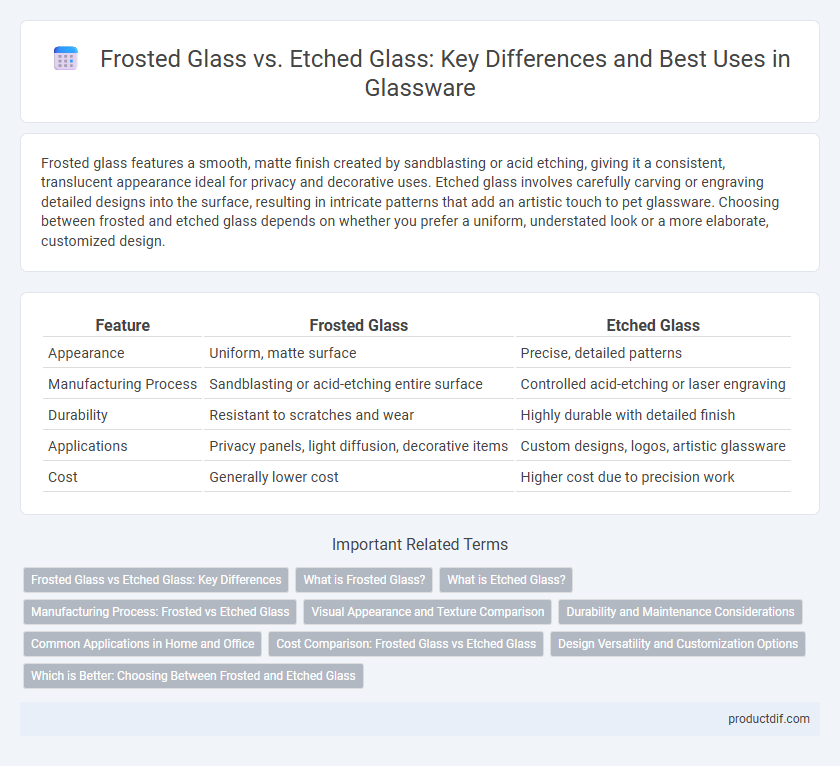Frosted glass features a smooth, matte finish created by sandblasting or acid etching, giving it a consistent, translucent appearance ideal for privacy and decorative uses. Etched glass involves carefully carving or engraving detailed designs into the surface, resulting in intricate patterns that add an artistic touch to pet glassware. Choosing between frosted and etched glass depends on whether you prefer a uniform, understated look or a more elaborate, customized design.
Table of Comparison
| Feature | Frosted Glass | Etched Glass |
|---|---|---|
| Appearance | Uniform, matte surface | Precise, detailed patterns |
| Manufacturing Process | Sandblasting or acid-etching entire surface | Controlled acid-etching or laser engraving |
| Durability | Resistant to scratches and wear | Highly durable with detailed finish |
| Applications | Privacy panels, light diffusion, decorative items | Custom designs, logos, artistic glassware |
| Cost | Generally lower cost | Higher cost due to precision work |
Frosted Glass vs Etched Glass: Key Differences
Frosted glass features a uniform, cloudy surface created through sandblasting or acid etching for privacy and light diffusion, while etched glass displays detailed designs or patterns carved or sandblasted into specific areas. Frosted glass provides a consistent matte finish ideal for windows and partitions, whereas etched glass offers decorative customization often used in signage, awards, or artistic panels. Both types enhance aesthetics and privacy, but the key difference lies in frosted glass's overall texture versus etched glass's selective, intricate motifs.
What is Frosted Glass?
Frosted glass is created by sandblasting or acid etching clear glass to produce a translucent, matte surface that diffuses light while maintaining privacy. This type of glass is popular in both residential and commercial interiors for windows, doors, and partitions due to its ability to obscure visibility without blocking natural light. Unlike etched glass, which often features decorative patterns or designs, frosted glass typically has a uniform, smooth finish that enhances softness and reduces glare.
What is Etched Glass?
Etched glass is a type of glass that features designs or patterns created by abrasive materials or acid to remove layers from the surface, resulting in a smooth, frosted appearance with precise detailing. This technique allows for intricate, permanent designs that are more defined compared to the uniformly dull surface of frosted glass. Etched glass is commonly used in decorative windows, doors, and glassware to add elegance and privacy while maintaining translucency.
Manufacturing Process: Frosted vs Etched Glass
Frosted glass is created by sandblasting or acid etching the surface, producing a uniform, translucent finish that diffuses light. Etched glass involves a more detailed process using controlled acid or abrasive techniques to carve intricate designs or patterns into the surface. The manufacturing process of frosted glass emphasizes consistent opacity, while etched glass focuses on precise artistic detailing.
Visual Appearance and Texture Comparison
Frosted glass exhibits a uniformly matte surface created by acid or sandblasting, offering a soft, diffused light effect and a slightly rough texture that enhances privacy while maintaining translucence. Etched glass features intricate designs or patterns engraved into the surface, resulting in varying levels of opacity with a more detailed visual appearance and a smoother texture where the etching occurs. Both types provide distinct aesthetic qualities, with frosted glass emphasizing consistent diffusion and etched glass highlighting artistic detail and texture contrast.
Durability and Maintenance Considerations
Frosted glass features a sandblasted or acid-etched surface that provides moderate durability and resists scratches better than etched glass, which undergoes deeper engraving but can be more susceptible to damage over time. Maintenance of frosted glass is simpler, requiring only gentle cleaning with mild soap and water, while etched glass demands careful handling to avoid wear on detailed patterns. Both types benefit from avoiding abrasive materials, but frosted glass generally offers a longer-lasting finish with less intensive upkeep.
Common Applications in Home and Office
Frosted glass is commonly used in bathroom windows, shower doors, and office partitions to provide privacy while allowing light transmission. Etched glass often appears in decorative panels, cabinet doors, and conference room windows, adding an elegant, textured design element. Both types enhance aesthetic appeal and functionality in residential and commercial interiors.
Cost Comparison: Frosted Glass vs Etched Glass
Frosted glass generally costs less than etched glass due to its simpler production process involving sandblasting or acid etching. Etched glass requires more specialized craftsmanship and intricate designs, increasing labor and material expenses. For budget-conscious projects, frosted glass offers an affordable option without sacrificing aesthetic appeal, while etched glass commands a premium for detailed, artistic finishes.
Design Versatility and Customization Options
Frosted glass offers a smooth, translucent finish ideal for privacy while allowing light to pass through, making it highly versatile for modern and minimalist designs. Etched glass features intricate patterns or logos created through sandblasting or acid etching, providing extensive customization options for personalized and artistic aesthetics. Both types enhance interior and exterior spaces but differ in texture and design depth, catering to diverse architectural and decorative needs.
Which is Better: Choosing Between Frosted and Etched Glass
Frosted glass offers a smooth, uniform opacity ideal for privacy while allowing light to pass through, commonly used in office partitions and bathroom windows. Etched glass features intricate designs or patterns created by acid or sandblasting techniques, providing both decorative appeal and partial opacity for aesthetic enhancement in interior decor. The choice between frosted and etched glass depends on whether the priority is functional privacy and diffuse light or artistic detail and customization.
Frosted Glass vs Etched Glass Infographic

 productdif.com
productdif.com